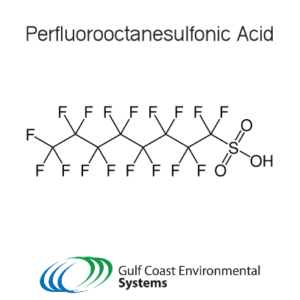PFAS in Landfills
By now, you have likely heard about PFAS, the “forever chemical.” What you may not know is that landfills are a major source of environmental PFAS contamination. So, what is this chemical, and how do we approach PFAS abatement in landfills?
What are PFAS and Why Are They a Challenge for Landfills?
PFOA & PFOS Perfluoroalkyl substances (PFAS) are a class of man-made, highly fluorine chemicals, that are facing strict regulatory restrictions in the near future. Though there are nearly 4,800 different types of perfluoroalkyl substances, there are two that are commonly focused on because of their use in everyday household products: perfluorooctanoic acid and perfluorooctanesulfonic acid. Both are considered stable chemicals, comprised of 8 carbons. The stability of these carbons and fluorine atoms is what makes them extremely persistent in the environment, and a problem in landfills, because they are very difficult to abate.
PFAS are incredibly common in the production of many consumer goods, from clothing and pots and pans to food packaging and automotive parts. Because of their prolific use, they can be found in every landfill. These compounds make it into the air and soil in a couple of different ways, making it a challenge to control.
- Many facilities burn their solid waste in order to reduce overfilling at landfill sites.
- Wastewater, or leachate, from landfills, can runoff into the soil.
These emissions of PFAS are troubling because PFAS are incredibly persistent, meaning they do not degrade naturally, over time. This is due to the stability of these carbons and fluorine atoms; this also makes PFAS difficult to abate. PFAS from landfills and wastewater facilities gave garnered a lot of attention in recent years, because of their known health risks. Studies have shown these higher levels of accumulation are directly tied to a number of concerning conditions, including liver issues, hypertension, developmental delays, high cholesterol, issues with immune responses, thyroid disease, pregnancy complications, and a number of different cancers.
How do We Treat PFAS in Landfills?
Water – Wastewater containing PFAS collected from landfills must go through a number of steps to achieve satisfactory destruction.
Step 1: Removing large particles (grit) using screens.
This is necessary to prevent damage and clogging to the facility’s pumps and equipment. A bar-type screen is generally used to achieve this, and the collected waste is then sent to landfills.
Step 2: Grit removal, using grit chambers.
The bar screens remove large debris but do not filter any of the smaller grit and sand out of the influent. This grit can cause damage to the downstream equipment and must be removed. Different types of grit chambers push a flow of water through the top of the chamber, allowing the grit particles to settle on the bottom. The remaining water and organic matter are then ready for the next step in the process.
Step 3: Sludge processing in a digester.
Water then flows through the tank at a rate at which the remaining solid organic matter in the influent separates from the water. This collected organic material is called sludge. The sludge, also known as slurry or biomass, is stored in the liquid manure storage area, where feeding liquid material and additional biomass quantities are feed into the system. It is then processed through a heated digester, which uses anaerobic digestion to break down the material. This is referred to as biofiltration. Biofiltration is the process of utilizing natural biological oxidation for the destruction and removal of VOCs, odors, and hydrocarbons. Simply put, biofiltration is the degradation of organic and inorganic substances by microorganisms.
Step 4: Leachate treatment.
The remaining liquid is known as leachate. After flowing through the tank to separate the sludge, the stream is still contaminated with compounds, like PFAS, that must be treated and removed before the water can be returned to the environment. This is achieved using a thermal oxidizer, and in some cases, an acid scrubber.
Air – Regenerative Thermal Oxidizer: This type of oxidizer uses extremely high heat, especially in the abatement of PFAS, to clean the exhaust of dangerous pollutants and compounds. Developed for large volumes, and low VOC concentration air pollution applications, Regenerative Thermal Oxidizer technology is based on using ceramic media as heat exchangers and switching valves. This design contrasts with Thermal Recuperative Oxidizers which use metallic heat exchanger technology, with primary and/or secondary heat. In a configuration utilizing a secondary heat exchanger, among other distinctions, the outgoing stream (typically fresh air) of the secondary heat exchanger process is routed to another part of the plant for its use or back to the process itself.
The high temperatures required to abate PFAS presents significant heat recovery opportunities. Waste heat using an RTO can be used to power a facility, offsetting the initial investment and operational cost of the equipment. In addition to lowering the dependency on utilities, using waste heat recovery to power a facility through pollution abatement equipment is a great way to reduce a landfill’s carbon footprint.
Other options for treating PFOA and PFOS would be a Thermal Recuperative Oxidizer, a Carbon Adsorber, or a Direct Fired Thermal Oxidizer. Regardless of the oxidation technology chosen, the system must include a quench or scrubber, to reduce the dangers of hydrofluoric acid emissions.
Since many scientists believe that the dangerously high concentration of PFAS found in soil and water sources across the globe is due to landfills and wastewater facilities. Pressure from regulatory agencies is increasing for these types of waste processing plants to find solutions for PFAS emissions is mounting. Gulf Coast Environmental Systems has extensive experience in PFAS treatment in dozens of applications, including waste processing.
This content was originally published on the GCE Systems website.

